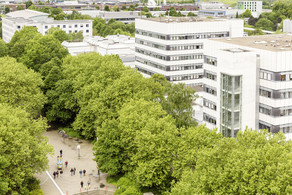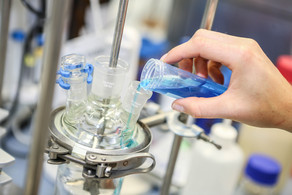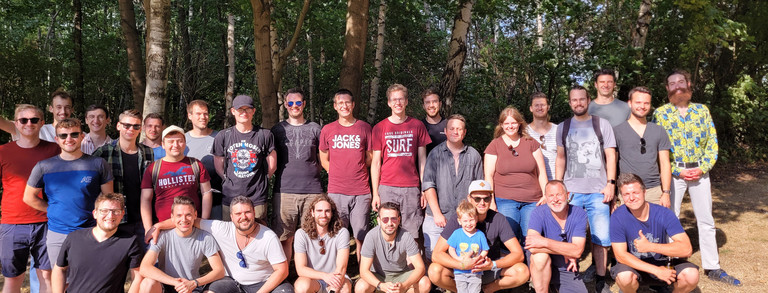M. Sc. Saqib Javed
Contact through the Secretariat:
monika.boschtu-dortmundde

Curriculum Vitae
Saqib Javed studied Bachelor of Science in Chemical Engineering from the Institute of chemical engineering and technology (ICET), University of the Punjab, Lahore-Pakistan in (2007-2011) and Master of Science in Chemical Engineering on Saudi Govt. Higher education Ministry scholarship from King Fahd University of Petroleum and Minerals (KFUPM), Dhahran (2013-15). He graduated with Master thesis titled “Fouling Mitigation of Reverse Osmosis Membrane using Layer by Layer (LBL) deposition of Polyelectrolytes”.
He served as a Lecturer in University of Wah, Wah Engineering College, Wah Cantt, Pakistan for one year (2016) and then in University of Engineering and Technology Lahore (New Campus), Pakistan for two years before he joined the TU dortmund.
In 2019, he joined TU Dortmund University as a DAAD scholar for doctoral studies (promotion) under the supervision of Prof. Dr. Dieter Vogt at the chair of industrial chemistry.
Research Topic
Polyethylene terephthalate (PET) waste is mounting up in the environment due to its poor biodegradability and low recycling rate. Glycolysis of PET is a promising chemical recycling technique to convert post-consumer PET waste into its monomer bis(2-hydroxy ethylene erephthalate) (BHET). The research topic includes the optimization of operating parameters influencing the chemical depolymerization of PET waste, thermodynamic and kinetic evaluation, improvement in the glycolysis methodology, optimization of crystallization conditions and investigating the suitability of synthesized BHET monomer into useful product.
The schematic diagram of the glycolysis process is as follows:


Publications & Conferences
-
Javed, S., Ropel, D., Vogt, D., (2023) "Sodium ethoxide as an environmentally benign and cost-effective catalyst for chemical depolymerization of post-consumer PET waste", Green Chem., 25, 1442-1452, DOI: 10.1039/D2GC04548F
-
Javed, S., Vogt, D., (2023) "Development of Eco-Friendly and Sustainable PET Glycolysis Using Sodium Alkoxides as Catalysts" ACS Sustainable Chem. Eng., 11, 31, 11541–11547, DOI: 10.1021/acssuschemeng.3c01872
- Javed, S., Fisse, J., Vogt, D., (2023) "Optimization and Kinetic Evaluation for Glycolytic Depolymerization of Post-Consumer PET Waste with Sodium Methoxide." Polymers. ; 15(3), 687, DOI: 10.3390/polym15030687.
-
Javed, S., Aljundi, I. (2021). "Tuning the RO membranes using the spin-assisted layer by layer assembly of polyelectrolytes". Desalination Water Treat. 209, 26-36, DOI: 10.5004/dwt.2021.26489.
- Khawar, A., Aslam, Z., Saqib, J., Abbas, A. (2018). "Pb(II) biosorption using DAP/EDTA-modified biopolymer (Chitosan)". Chem. Eng. Commun. 209 (11), 1555-1567, DOI: 10.1080/00986445.2018.1460598.
- Khalid, A., Abdel-Karim, A., Atieh, M. A., Javed, S., McKay, G. (2018). "PEG-CNTs nanocomposite PSU membranes for wastewater treatment by membrane bioreactor". Sep. Purif. Technol. 190, 165-176, DOI: 10.1016/j.seppur.2017.08.055.
- Javed, S., Aljundi, I. H., Khaled, M. (2017). "High fouling-resistance of polyamide desalination-membrane modified with PEI/PAH polyelectrolyte multilayers". J. Environ. Chem. Eng. 5 (5), 4594-4604, DOI: 10.1016/j.jece.2017.09.004.
- Javed, S., Aljundi, I. H. (2016). "Membrane fouling and modification using surface treatment and layer-by-layer assembly of polyelectrolytes: State-of-the-art review". J. Water Process Eng. 11, 68-87, DOI: 10.1016/j.jwpe.2016.03.009.
- June 2022, Weimar, Germany: 55. Jahrestreffen Deutscher Katalytiker, "Homogeneous or heterogeneous? Kinetics of catalytic depolymerization of post-consumer PET"
- October 2021, Online, DGMK-Chemical Recycling – Beyond Thermal Use of Plastic and other Waste, "Chemical Depolymerization of PET Waste using Sodium Ethoxide as Catalyst: Five-factor Optimization Using Response Surface Methodology"






